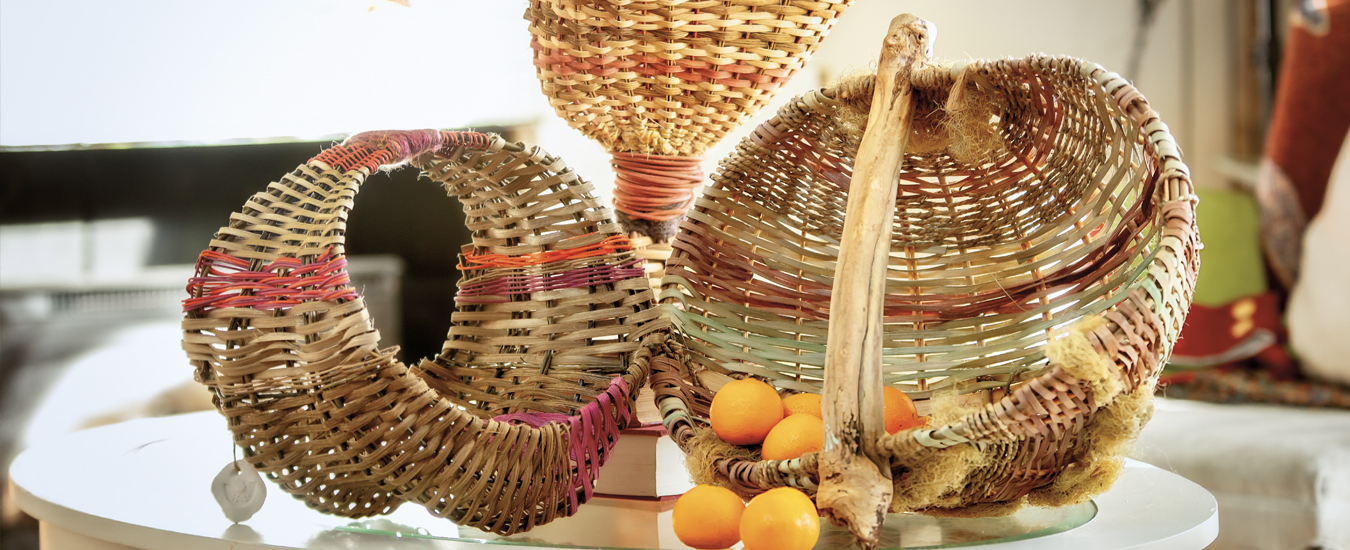Early morning sun is bathing Windsor, N.S., in golden light when Virginia Douglas opens her home’s door to a visitor. Originally hailing from near Toronto, Douglas was living in on Gabriola Island, B.C., when she started noticing that driftwood covered the beaches. A long-time graphic artist and painter, she felt the need to recycle and repurpose some of that found treasure, and began painting scenes on flatter pieces. Then, she says, “I hit a roadblock and became bored with working in two dimensions.”
While on a trip to Ireland, a friend introduced her to basket weaving artist and author Joe Hogan, and she was immediately smitten. “He incorporated driftwood into his baskets, and it was a true ‘aha’ moment for me,” she says. Upon returning to B.C., she took a class in basketmaking from Marylyn Beaubien on Gabriola Island, which taught her to use driftwood in creating baskets. Douglas says, “That added to the feeling that I needed to weave baskets, and I went promptly crazy with them.”
Ireland and its basket makers made a lasting impression. Douglas has returned for many visits and to take workshops. She’d love to live in Ireland but, “Canada’s East Coast was as close as I could get at this point in my life, so I moved to Windsor in December 2021.” At the time the region was still deep in COVID lockdowns, but restrictions were easing, and she and her realtor found the bungalow near Windsor.
Douglas works full time by telecommute as an engineering project technician for a B.C. company, so she starts her workdays at 10 a.m. and finishes at 6 p.m. That leaves her plenty of time for making her artworks. She weaves with a variety of natural materials, starting with driftwood for the basket handle, then weaving the frame and body with thin branches and twigs from willows, red-osier dogwoods, and honeysuckle. Depending on the design and her mood, Douglas may also incorporate other foraged materials such as birch bark and lichens such as old man’s beard, dried flowers, sea grass and reeds. Hues vary so she also uses fabric dye or dyes with natural materials such as beets, coffee, and wildflowers to achieve some colours. Each piece also has a little ornament made of polymer clay as a unique finishing touch. The baskets use a lot of material: even a small basket some six to eight inches wide can use more than 70 or 80 pieces of willow in its construction.
 The process begins with a piece of driftwood, which determines the shape and size of item she’ll make. It can take up to seven hours to make a basket, which she makes for different purposes: she has market baskets and egg gathering baskets, among others, and is currently learning to make woven carriers for bicycles, which she’ll market through a local bike shop.
The process begins with a piece of driftwood, which determines the shape and size of item she’ll make. It can take up to seven hours to make a basket, which she makes for different purposes: she has market baskets and egg gathering baskets, among others, and is currently learning to make woven carriers for bicycles, which she’ll market through a local bike shop.
In Ireland, most basket makers are men. However, Douglas teaches classes in basket weaving in town through the Windsor Makery, and says she has yet to have a man take her course. “Occasionally a guy will buy a basket, but for the most part women here seem to be the most interested in the process or the finished item,” she says.
Asked how she markets, she says with a chuckle, “I don’t, not really!” She has taken part in the Windsor Garlic Festival which happens in downtown Windsor every September, and also sells at the farmers market in Wolfville, where she has applied to be a permanent part-time participant for next year, selling biweekly. Ideally, she’d like to do a circuit of a few markets, in part because she enjoys the social side of the venues as much as she does sellng her work.
The Windsor Makery, also downtown, has been a terrific place to get to know other artists, she says, plus she has a few items on consignment in the store. When Douglas moved to Nova Scotia, she brought a pile of driftwood with her, and also some foraged pieces of bark from massive old Douglas firs, with which she has been creating rustic and fun keyholders, garnished with shells, semi-precious stones, and other unique ephemera.
Every basket is unique. “Each item gives me some challenges, and gives me a chance to improve my techniques and creativity,” she says. “Plus they’re useful as well as beautiful. I hope they make others happy, too.”
